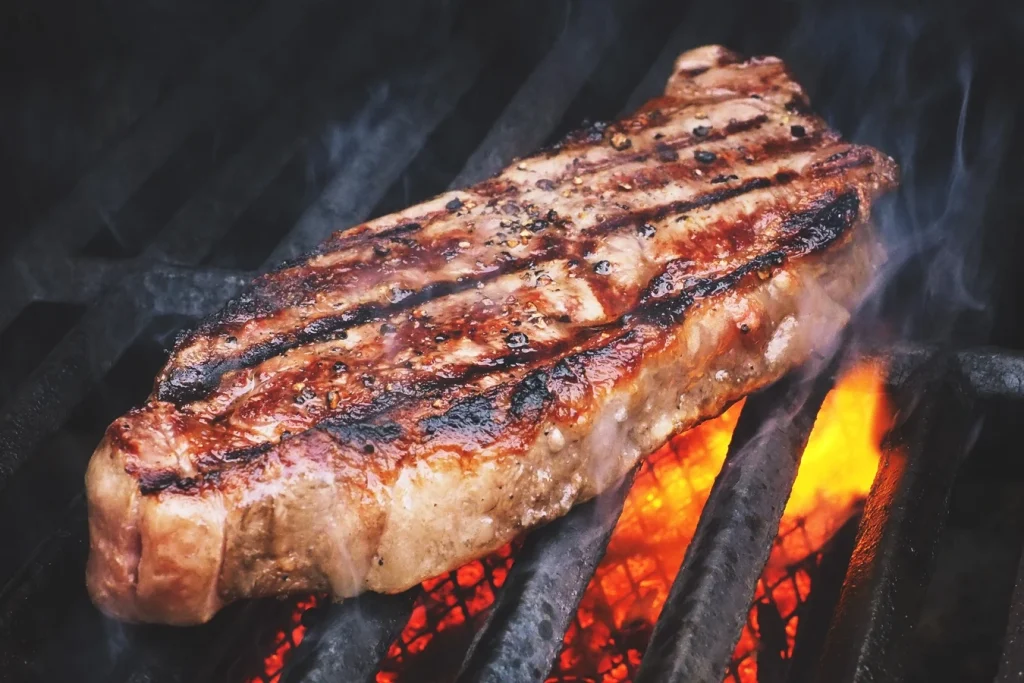The Best Fluffy Pancakes recipe you will fall in love with. Full of tips and tricks to help you make the best pancakes.
If you’re a steak lover searching for that perfect cut that combines tenderness, rich marbling, and bold flavor, the Delmonico steak is your ultimate go-to. Known for its juicy, buttery texture and steakhouse-quality taste, this iconic cut has been a favorite for generations, originally made famous by the legendary Delmonico’s Restaurant in New York City.
In this post, I’m going to share with you a foolproof Delmonico steak recipe that guarantees a mouthwatering experience every time — whether you’re cooking it on a cast iron skillet or grilling outdoors. From selecting the right cut to mastering the perfect seasoning and cooking techniques, get ready to elevate your steak game to a whole new level.
Let’s dive in and discover how to create a restaurant-worthy Delmonico steak right in your own kitchen!
What Is a Delmonico Steak?
When it comes to steaks, the Delmonico steak holds a special place in American culinary history—and it’s no wonder why. But despite its fame, many people are often confused about what exactly a Delmonico steak is. Let’s clear that up and explore what makes this cut so unique and delicious.

History & Origin
The Delmonico steak takes its name from Delmonico’s Restaurant, which opened in New York City in the 1830s and quickly became one of America’s first fine-dining establishments. This iconic steakhouse popularized the cut and gave it a name synonymous with luxury and quality. Over time, the exact definition of what constitutes a “Delmonico steak” has evolved and can vary depending on who you ask—but it’s always associated with a high-quality, flavorful steak that’s thick-cut and tender.
What Cut of Meat Is a Delmonico Steak?
There isn’t a single universally agreed-upon cut called the Delmonico steak, which sometimes causes confusion. Generally, the term refers to a boneless cut from the rib section of beef—commonly the ribeye, but it can also be from the strip loin or boneless chuck eye. What sets it apart is the generous marbling (intramuscular fat), which melts during cooking, creating the juicy, buttery texture Delmonico steaks are known for. If you ask your butcher for a Delmonico, they’ll often direct you toward one of these cuts.
Why Is It Prized by Steak Lovers?
The Delmonico steak’s reputation isn’t just about history—it’s about taste and texture. Thanks to its marbling, this cut delivers incredible flavor with every bite. It’s tender enough to slice easily but has enough fat to keep it juicy and satisfying, making it a top choice for steakhouse menus. Whether pan-seared or grilled, a well-prepared Delmonico steak will develop a beautifully caramelized crust while staying succulent inside.
In short, if you want a steak that balances tenderness, flavor, and a little bit of indulgence, the Delmonico is a perfect pick. And with this recipe, you’ll be able to recreate that steakhouse experience at home, impressing family and friends alike.
Ingredients You’ll Need for the Best Flavor
Creating the perfect Delmonico steak starts with choosing the right ingredients. While the star of the show is undoubtedly the steak itself, the supporting cast of seasonings, fats, and aromatics will elevate the flavor and turn your dish from good to unforgettable. Here’s everything you’ll need to make this steakhouse favorite shine.
The Meat: Choosing Your Steak
For an authentic and juicy Delmonico steak, start with a high-quality cut. Look for a USDA Prime or Angus beef Delmonico steak, known for excellent marbling and tenderness. Marbling refers to the thin streaks of fat interspersed within the muscle—this fat melts during cooking and keeps the steak juicy and flavorful. If you can’t find a cut labeled “Delmonico,” ask your butcher for a boneless ribeye, strip loin, or boneless chuck eye steak with good marbling.
Seasoning: Keep It Simple but Effective
The seasoning for a Delmonico steak doesn’t need to be complicated. The goal is to enhance the natural flavor of the beef without overpowering it.
- Kosher salt: Use generously to create a flavorful crust. Salt also helps to tenderize the steak.
- Freshly ground black pepper: Adds a subtle heat and depth. Apply right before cooking to keep it fresh.
- Optional: Garlic powder or smoked paprika for an extra layer of flavor if you like a slight smoky or garlicky touch.
Cooking Fat: Butter and Olive Oil Combo
Cooking fat is crucial for achieving that perfect sear and rich flavor.
- Olive oil is ideal for its high smoke point and mild flavor, helping you get a golden-brown crust without burning.
- Unsalted butter adds richness and helps baste the steak, infusing it with deep, savory notes. Often, you’ll start cooking with olive oil and finish with butter during the last minutes of searing.
Aromatics: The Secret Flavor Boosters
Aromatics like fresh herbs and garlic cloves add subtle fragrance and complexity to your steak. As the butter melts, it carries the essence of these aromatics into the meat.
- Garlic cloves (crushed or smashed)
- Fresh rosemary or thyme sprigs—both bring an earthy aroma that pairs perfectly with beef.
Optional Extras: For Those Who Want to Experiment
If you want to take your Delmonico steak to the next level, consider these:
- Steak seasoning blends that combine salt, pepper, garlic, onion, and other spices.
- Smoked sea salt for a unique smoky flavor without grilling.
- A splash of Worcestershire sauce or soy sauce in your marinade or butter basting mix for umami depth.
Using these carefully selected ingredients will help you cook a Delmonico steak bursting with flavor, just like you’d find in your favorite steakhouse. Ready for the cooking steps? Let me know if you want me to expand on that next!
How to Cook a Delmonico Steak Perfectly
Cooking a Delmonico steak to juicy, tender perfection is easier than you might think—but it requires attention to detail and the right techniques. Whether you prefer pan-searing in a cast iron skillet or grilling over an open flame, these step-by-step instructions will help you master a steak that’s beautifully caramelized on the outside and tender, flavorful on the inside.
Step 1: Preparation Is Key
Before you even turn on the heat, make sure your steak is properly prepped. Take the Delmonico steak out of the refrigerator about 30 to 45 minutes before cooking to bring it to room temperature. This helps it cook more evenly. Pat the steak dry with paper towels to remove excess moisture—this is essential for getting a nice crust.
Generously season both sides of the steak with kosher salt and freshly ground black pepper. Don’t be shy; a good layer of seasoning creates that savory crust steak lovers crave.
Step 2: Choose Your Cooking Method
Pan-Searing in a Cast Iron Skillet
- Heat your cast iron skillet over medium-high heat until very hot—this is crucial to achieve a perfect sear.
- Add a tablespoon of olive oil and swirl to coat the pan.
- Place the steak in the skillet and let it cook undisturbed for about 3–4 minutes on the first side. Resist the urge to move it around, so a rich crust forms.
- Flip the steak and add a couple of tablespoons of unsalted butter, along with crushed garlic cloves and sprigs of fresh rosemary or thyme.
- As the butter melts, tilt the pan slightly and use a spoon to baste the steak repeatedly with the flavorful butter mixture for another 3–4 minutes, or until it reaches your desired doneness.
Pro Tip: Using a high-quality, heavy-bottom skillet can make all the difference for even heat distribution and that perfect sear. I recommend checking out the Ninja NeverStick Skillet—it’s non-stick, dishwasher safe, and ideal for achieving that perfect crust without sticking.
Grilling Over High Heat
- Preheat your grill to high heat (about 450°F to 500°F).
- Brush the steak lightly with olive oil to prevent sticking.
- Place the steak on the grill and cook for 4–5 minutes per side, depending on thickness and desired doneness.
- During the last minute, you can add a pat of butter and fresh herbs on top to melt over the steak, adding richness.
Step 3: Use a Meat Thermometer for Perfect Doneness
To ensure your Delmonico steak is cooked just the way you like it, use a meat thermometer. Here are the ideal internal temperatures to aim for:
- Rare: 120–125°F
- Medium-rare: 130–135°F (recommended for best flavor and tenderness)
- Medium: 140–145°F
- Well done: 160°F and above (not recommended for this cut)
Insert the thermometer into the thickest part of the steak to get an accurate reading.
Step 4: Resting Your Steak
Once cooked, remove the steak from the heat and let it rest for 5 to 10 minutes on a cutting board tented loosely with foil. Resting allows the juices to redistribute throughout the meat, ensuring every bite is juicy and tender. Cutting into your steak too early will cause those flavorful juices to run out.
Step 5: Serving Suggestions
Slice your Delmonico steak against the grain to maximize tenderness. Serve with a pat of garlic herb butter on top, or alongside classic steakhouse sides like garlic mashed potatoes, grilled asparagus, or a fresh arugula salad.
By following these detailed steps, you’ll consistently cook a Delmonico steak that’s packed with flavor, perfectly seared, and tender—just like in your favorite steakhouse. Ready to take your steak dinner to the next level? Keep reading for tips to elevate your steak game even further.
Tips for Steakhouse-Quality Results at Home
Cooking a Delmonico steak at home that rivals what you’d find in a top steakhouse is totally achievable with a few expert tips and tricks. These small but impactful techniques will help you unlock restaurant-quality flavor, texture, and presentation right in your own kitchen.
1. Start with Quality Meat
The foundation of a great steak is, without question, the quality of the meat you choose. Look for cuts with good marbling—those thin veins of fat within the muscle that melt during cooking and keep your steak juicy and flavorful. Buying from a trusted butcher or choosing USDA Prime or Choice grades can make a noticeable difference. Don’t hesitate to ask your butcher for recommendations on Delmonico-style cuts.
2. Bring Your Steak to Room Temperature
One common mistake is cooking steak straight from the fridge. Bringing the steak to room temperature for about 30 to 45 minutes before cooking helps it cook more evenly, preventing the outside from overcooking while the inside remains underdone.
3. Master the Dry Seasoning
Keep your seasoning simple and let the meat shine. Use plenty of kosher salt and freshly ground black pepper. Salt enhances flavor and helps form a beautiful crust during searing. For extra flavor, you can lightly dust the steak with garlic powder or smoked paprika, but avoid overpowering the natural beef taste.
4. Preheat Your Cooking Surface Properly
Whether you’re using a cast iron skillet or a grill, make sure it’s hot enough before adding the steak. A screaming hot surface is essential for that Maillard reaction — the chemical process that creates the steak’s characteristic brown crust and deep flavor. For cast iron, this means heating the pan until it’s almost smoking; for grills, preheat to around 450°F–500°F.
5. Use a Combination of Oil and Butter
Start searing your steak with a high-smoke point oil like olive oil or grapeseed oil to get a perfect crust without burning. In the last few minutes, add unsalted butter along with aromatics like garlic and fresh herbs (rosemary or thyme) to baste the steak. This basting technique infuses the meat with rich, savory flavors and a beautiful glossy finish.
6. Don’t Overcrowd the Pan or Grill
If you’re cooking multiple steaks, avoid crowding them. Giving each steak enough space ensures even heat circulation and prevents steaming, which can ruin your crust. Cook steaks in batches if necessary.
7. Use a Meat Thermometer for Precision
Achieving your preferred level of doneness is much easier with a reliable meat thermometer. Insert it into the thickest part of the steak to get an accurate reading. This removes the guesswork and guarantees consistently juicy, tender results.
8. Let Your Steak Rest Before Slicing
Patience is key! Rest your steak for at least 5 to 10 minutes after cooking, loosely covered with foil. This step lets the juices redistribute evenly throughout the meat, preventing a dry steak and making every bite flavorful and moist.
9. Slice Against the Grain
When it’s time to serve, always slice your Delmonico steak against the grain—meaning perpendicular to the direction of the muscle fibers. This shortens the fibers and makes the steak easier to chew, enhancing tenderness.
10. Pair With Classic Sides and Sauces
To round out your steakhouse experience, serve your Delmonico steak with classic sides like garlic mashed potatoes, grilled asparagus, or a fresh green salad. For sauces, simple herb butter or a red wine reduction can add that extra touch of elegance.
By following these tips, you’ll not only cook an incredible Delmonico steak but also create a complete steakhouse dining experience that will impress any guest. Cooking steak perfectly is an art, but with practice and these insider tips, you’ll become a pro in no time.
Frequently Asked Questions About Delmonico Steak
If you’re new to cooking or ordering Delmonico steak, you probably have a few questions about this classic cut. To help you out, here are some of the most frequently asked questions about Delmonico steak, answered in detail to give you the confidence to enjoy and prepare this delicious steak perfectly.
What Exactly Is a Delmonico Steak?
The term Delmonico steak has a bit of a mysterious history, but it generally refers to a thick, well-marbled steak cut from the ribeye, strip loin, or sometimes the chuck eye. It originated from Delmonico’s Restaurant in New York City in the 1800s, where it became famous as a premium steak choice. Because there’s no single official cut, the name “Delmonico steak” can vary by region and butcher. Generally, it’s known for tenderness and rich flavor.
How Is Delmonico Steak Different From Ribeye or New York Strip?
While a ribeye is usually boneless with intense marbling and a soft texture, a New York strip is leaner with a tighter grain. Delmonico steaks may come from either of these cuts or similar ones but are typically cut thicker and served boneless. The main difference lies in the thickness and the classic association with the Delmonico name rather than a strict cut definition.
What Is the Best Way to Cook a Delmonico Steak?
The best cooking methods for a Delmonico steak are pan-searing in a cast iron skillet or grilling over high heat. These methods help develop a flavorful crust while keeping the inside juicy and tender. Using a meat thermometer to check for doneness and allowing the steak to rest after cooking are key steps for the best results.
How Thick Should a Delmonico Steak Be?
Delmonico steaks are typically cut between 1 to 2 inches thick. Thicker cuts allow for a better sear on the outside while maintaining a juicy interior. If the steak is too thin, it can easily overcook and lose tenderness.
Should I Marinate a Delmonico Steak?
While marinating can add flavor, a high-quality Delmonico steak with good marbling often doesn’t require it. Simple seasoning with salt and pepper highlights the natural beef flavor best. However, if you want to experiment, a light marinade with ingredients like soy sauce, garlic, or Worcestershire sauce for 30 minutes can add a tasty twist.
Can I Freeze Delmonico Steak?
Yes! You can freeze Delmonico steaks if you want to store them for longer periods. Wrap them tightly in plastic wrap and then place them in a freezer-safe bag or container to prevent freezer burn. When ready to cook, thaw the steak slowly in the refrigerator overnight for best texture and flavor.
What Are Good Side Dishes for Delmonico Steak?
Classic steakhouse sides pair beautifully with Delmonico steak. Some favorites include garlic mashed potatoes, creamed spinach, grilled asparagus, and a fresh green salad. For sauces, try herb butter, chimichurri, or a red wine reduction to complement the steak’s richness.
Is Delmonico Steak Expensive?
Delmonico steak tends to be on the pricier side compared to other cuts because of its thickness, marbling, and premium quality. Prices vary depending on the source and grade of the beef but investing in a good Delmonico steak means enjoying exceptional flavor and tenderness.






[…] Want to master the perfect steak for your BBQ feast? Check out this incredible guide on cooking the best Delmonico steak: The Best Delmonico Steak Recipe. […]